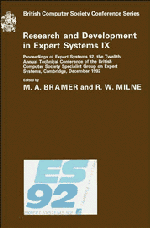Book contents
- Frontmatter
- Contents
- Preface
- Introduction
- CONSULTANT: providing advice for the machine learning toolbox
- A methods model for the integration of KBS and conventional information technology
- KBS methodology as a framework for co-operative working
- Project management for the evolutionary development of expert systems
- The specification and development of rule-based expert systems
- Towards a method for multi-agent system design
- Jigsaw: configuring knowledge acquisition tools
- On the relationship between repertory grid and term subsumption knowledge structures: theory practice tools
- Strategy maze: an on-line tool for support management of the knowledge acquisition process
- Concurrent engineering using collaborating truth maintenance systems
- Ockham's razor as a gardening tool
- A designer's consultant
- Fairness of attribute selection in probabilistic induction
- An application of case-based expert system technology to dynamic job-shop scheduling
- Neural network design via LP
- KEshell2: an intelligent learning data base system
- Approaches to self-explanation and system visibility in the context of application tasks
- An object oriented approach to distributed problem solving
- Intelligent user interface for multiple application systems
- Combining qualitative and quantitative information for temporal reasoning
- Documents as expert systems
Approaches to self-explanation and system visibility in the context of application tasks
Published online by Cambridge University Press: 04 August 2010
- Frontmatter
- Contents
- Preface
- Introduction
- CONSULTANT: providing advice for the machine learning toolbox
- A methods model for the integration of KBS and conventional information technology
- KBS methodology as a framework for co-operative working
- Project management for the evolutionary development of expert systems
- The specification and development of rule-based expert systems
- Towards a method for multi-agent system design
- Jigsaw: configuring knowledge acquisition tools
- On the relationship between repertory grid and term subsumption knowledge structures: theory practice tools
- Strategy maze: an on-line tool for support management of the knowledge acquisition process
- Concurrent engineering using collaborating truth maintenance systems
- Ockham's razor as a gardening tool
- A designer's consultant
- Fairness of attribute selection in probabilistic induction
- An application of case-based expert system technology to dynamic job-shop scheduling
- Neural network design via LP
- KEshell2: an intelligent learning data base system
- Approaches to self-explanation and system visibility in the context of application tasks
- An object oriented approach to distributed problem solving
- Intelligent user interface for multiple application systems
- Combining qualitative and quantitative information for temporal reasoning
- Documents as expert systems
Summary
ABSTRACT
The degree to which users understand and accept advice from Knowledge-Based Systems can be increased through explanation. However, different application tasks and different sets of users place diverse requirements on an explanation component of a Knowledge-Based System. Thus, the degree of portability of explanation components between applications is reduced. This paper discusses the aspects of explanation that change between application tasks and those that are required for any satisfactory explanation. The requirements placed on Knowledge-based Systems resulting from explanatory capabilities raises implications for the structure and contents of the knowledge-base and the visibility of the system. The discussion is illustrated by four Knowledge-Based System projects.
INTRODUCTION
An important feature of knowledge-based systems compared to other information-providing systems is that the knowledge on which they are based is represented explicitly in the system rather than hidden in the design of the system, or represented implicitly in an algorithm. The knowledge can therefore be used not only to solve the problem for which the knowledge-based system was built, but also to show the user what knowledge is used to solve the problem and hence go some way to explain the system's behaviour. However, whilst the explicitness of the knowledge makes it possible to provide some explanatory capability, it does not necessarily mean that the system is capable of producing every explanation required by its users. Some explanations require further reasoning and knowledge to retrieve and act on the knowledge already present in the knowledge-based system.
- Type
- Chapter
- Information
- Research and Development in Expert Systems IX , pp. 273 - 284Publisher: Cambridge University PressPrint publication year: 1993

